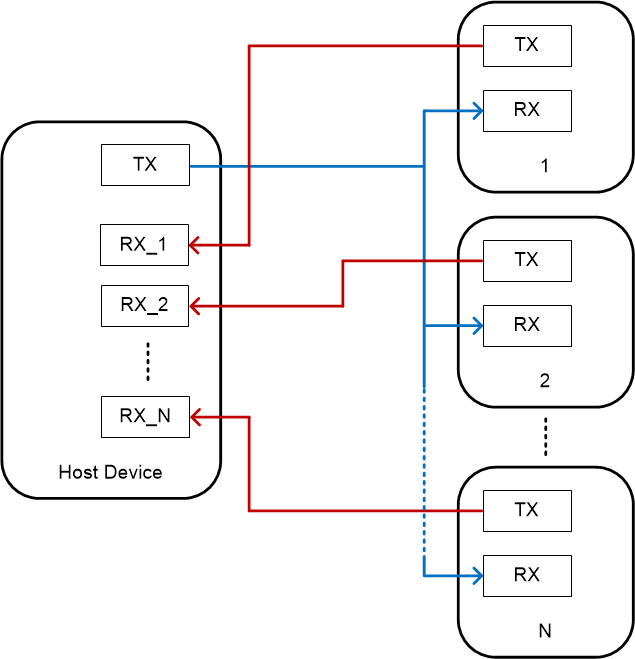SPRACM3E August 2021 – January 2023 F29H850TU , F29H859TU-Q1 , TMS320F280021 , TMS320F280021-Q1 , TMS320F280023 , TMS320F280023-Q1 , TMS320F280023C , TMS320F280025 , TMS320F280025-Q1 , TMS320F280025C , TMS320F280025C-Q1 , TMS320F280033 , TMS320F280034 , TMS320F280034-Q1 , TMS320F280036-Q1 , TMS320F280036C-Q1 , TMS320F280037 , TMS320F280037-Q1 , TMS320F280037C , TMS320F280037C-Q1 , TMS320F280038-Q1 , TMS320F280038C-Q1 , TMS320F280039 , TMS320F280039-Q1 , TMS320F280039C , TMS320F280039C-Q1 , TMS320F280040-Q1 , TMS320F280040C-Q1 , TMS320F280041 , TMS320F280041-Q1 , TMS320F280041C , TMS320F280041C-Q1 , TMS320F280045 , TMS320F280048-Q1 , TMS320F280048C-Q1 , TMS320F280049 , TMS320F280049-Q1 , TMS320F280049C , TMS320F280049C-Q1 , TMS320F28384D , TMS320F28384S , TMS320F28386D , TMS320F28386S , TMS320F28388D , TMS320F28388S , TMS320F28P650DH , TMS320F28P650DK , TMS320F28P650SH , TMS320F28P650SK , TMS320F28P659DH-Q1 , TMS320F28P659DK-Q1 , TMS320F28P659SH-Q1
- Using the Fast Serial Interface (FSI) With Multiple Devices in an Application
- Trademarks
- 1Introduction to the FSI Module
- 2FSI Applications
- 3Handshake Mechanism
- 4Sending and Receiving FSI Data Frames
- 5Daisy-Chain Topology Tests
- 6Star Topology Tests
-
7Event Synchronization Over FSI
- 7.1 Introduction
- 7.2 C2000Ware FSI EPWM Sync Examples
- 7.3 Additional Tips and Usage of FSI Event Sync
- 8References
- 9Revision History
2 FSI Applications
In terms of the trend in power electronic applications, the increasing demand for higher power levels makes multiple power modules in parallel much more popular. Examples of such applications include industrial drives, telecom rectifiers, server power supplies, on-board chargers, and so forth. Meanwhile, to achieve a complex system with high performance, multiple MCUs are commonly used and must operate in a synchronized fashion. Thus, critical data, including protection signals, sampling parameters, and even control loop data, needs to be transferred with the fastest speed and least amount of latency among multiple devices/modules. FSI will be more suitable to handle this when compared to the traditional Controller Area Network (CAN), Serial Peripheral Interface (SPI) or Universal Asynchronous Receiver/Transmitter (UART).
There are a number of communication network topologies for connecting multiple devices, each with their own benefits. A ring topology can be created by connecting multiple devices with FSI communication in a daisy-chain fashion. The advantages of a ring topology are that each device only needs one FSI transmitter and receiver and also the simplicity from a physical connection perspective. Figure 2-1 shows a daisy-chain connection system for N (N≥2) node devices, where each device (index i) connects with the FSITX of device i-1 and FSIRX of device i+1.
 Figure 2-1 Daisy-Chain Connection
Example
Figure 2-1 Daisy-Chain Connection
ExampleOne disadvantage of the above daisy-chain topology is that if one device in the chain fails then the entire communication link is broken. Another downside is that devices must forward data along to the next device in the chain if the received data is intended for a subsequent device. This can add to the overall latency of when a data packet is transmitted and when the respective device in the chain receives the data.
One communication topology that solves the broken link issue and can reduce the device-to-device latency is a star topology, where several nodes connect directly to one central host device. Figure 2-2 shows a star topology system with N (N≥2) node devices.
 Figure 2-2 Star Topology Example
Figure 2-2 Star Topology ExampleThe host device's FSI transmitter is connected to the FSI receiver of each node device in order for the host to broadcast data packets to all nodes simultaneously. The node device transmitter's, on the other hand, are connected to independent receivers of the host device enabling them to send data directly back to the host at any time. This star implementation comes with a resource cost as the host needs N number of independent FSI receiver modules. The F2838x family of C2000 devices fit into the host socket with having two FSI transmitters and eight FSI receivers.